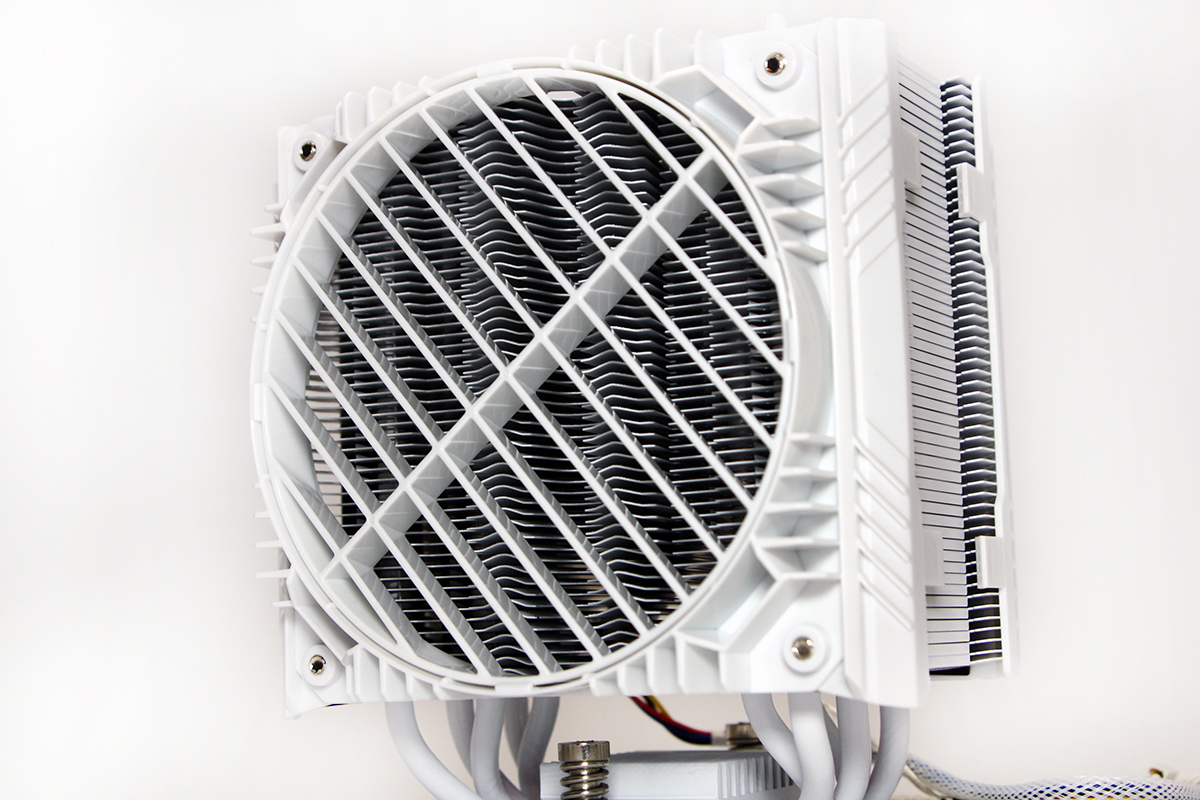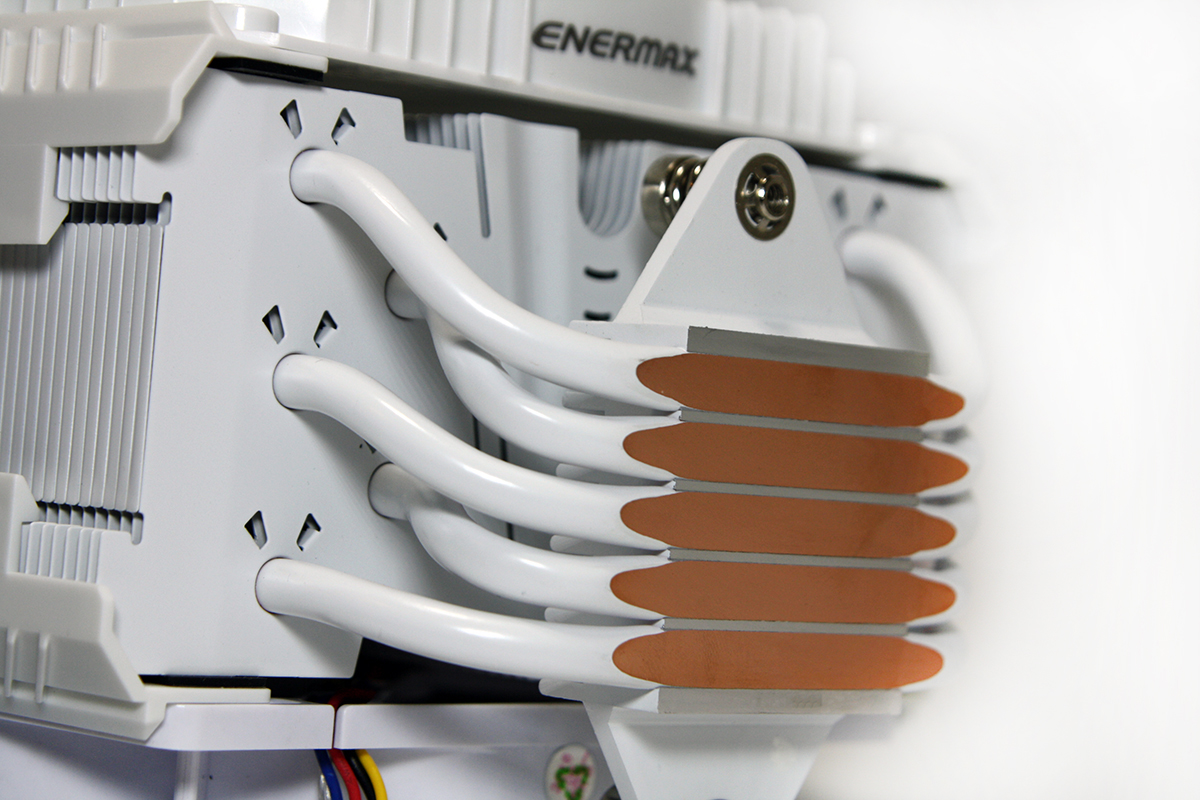Early Verdict
This is a fine five-heatpipe CPU cooler for just above $50, delivering overclocked cooling potential without breaking the bank.
Pros
- +
Cooling performance
- +
Simple installation and solid, integrated mounting hardware
- +
Quiet operation, even at 100% speeds
- +
Directional rear diffuser
Cons
- -
Limited color choice (black or white)
Why you can trust Tom's Hardware
Features & Specifications
Enermax is known as a maker of PC power supplies and cooling fans, but it has also been expanding its brand by producing CPU air and liquid coolers aimed at the performance market. Enter the ETS-T50 Axe, Enermax’s current flagship CPU air cooler. It is a large, direct-contact, five-heatpipe unit with some interesting features.
In the spirit of keeping it simple, the ETS-T50 Axe is available either painted black or white; ours happened to be the handsome, matte-white finish. The front fan (120x25mm, branded by Enermax) is rated at 62.32 CFM at 1800 RPM and sports 36 white LEDs around the circumference. The lights can cycle through five lighting patterns manually using a small, connected button switch.
The fan blades themselves have shiny silver-adhesive strips, causing a mirror-ball reflection of the lighting at operating speeds. When the PC boots up, the cooling fan runs a 10-second phase of reverse cycling to help rid the blade surfaces of dust accumulation. The fan is powered by a four-pin PWM connector, and the fan cabling itself is sleeved in white nylon braid to match the rest of the cooler. The LED switch is really the only awkward component of the entire cooler, as it is a simple button at the end of a 5.0” (127mm) wire that dangles alongside the four-pin PWM cable.
Instead of a second fan, the rear of the ETS-T50 houses a unique directional air diffuser. It rotates 360° to project warm exhaust air toward the nearest case fan of your choice. The slats of the diffuser are also angled to assist with directional funneling, and like the fan, it snaps on and off the ETS-T50 easily by means of side clip brackets.
Enermax designed the ETS-T50 to make use of directional airflow within the cooling tower, adding angular folds of the cooling fins themselves, as well as vortex wings around each heatpipe for air channeling.
Five direct-contact copper heatpipes, plus an integrated aluminum block base, are milled to a near-mirror finish, with nearly seamless surface mating of the copper and aluminum.
The tower base top is engineered with cooling fins milled into the aluminum block. Spring-tension screws are permanently affixed to the side wings using snap retainers, which should help end the balancing-act dramatics among the CPU cooler, a screwdriver, and not enough hands.
Get Tom's Hardware's best news and in-depth reviews, straight to your inbox.
Enermax ships the ETS-T50 Axe with hardware to support most current Intel and AMD sockets, although Threadripper currently does not make the list. A generous amount of Enermax's Dow Corning TC-5121 thermal paste comes in the box, with a syringe applicator and a spreader.
One item that is not included, but that is almost necessary for installation, is a very long Phillips screwdriver. You will need it to reach the back spring-mounted bolt, which is hidden beneath cutouts in the cooling fins and due to the 0.75” (19mm) rear offset. It is possible to reach the screw from a slight angle, but the face of the bolt head is rather shallow, making it prone to stripping with the teeth of a screwdriver. A visit to your favorite hardware location (alas, likely not called "Tom’s Hardware") can alleviate this problem.
Installed, the ETS-T50 Axe does retain a slight overall rear offset of just over a quarter inch (6.4mm), as the rear diffuser is slimmer than the cooling fan out front. Having installed the cooling tower with the fan and directional diffuser removed, they now easily snap on around the front and rear face of the cooler. The "V" design seen on the top cooling fin, as well as the "closed" sides of the interlocking fins, gives us a glimpse into the air channeling within the cooling tower. And while the cooler is slightly offset, we still didn’t witness any interference with large memory DIMMs.
MORE: Best CPU Cooling
MORE: How To Choose A CPU Cooler
MORE: All Cooling Content
- 1
- 2
Current page: Features & Specifications
Next Page Comparison Coolers, Testing Results & Conclusion
Garrett Carver is a contributor for Tom’s Hardware, primarily covering thermal compound comparisons and CPU cooling reviews; both air and liquid, including multiple variations of each.
-
HEXiT i like what they have done with the fan shroud as the blades of the fans dont exceed the hight of the cooling fin stack which means in theory the fan is more efficient... but they have lopped out chunks of the cooling surface which means the air will try and flow out of them reducing the effective cooling and air flow over the rest of the cooling stack.Reply
the whole thing could be a great cooler if they just go with straight edges on the fins that butt up directly to the back of the fan. but as it is i would have reservations. -
dish_moose If I recall black body radiators are the best at transferring heat - white may look pretty but ugly is as ugly does - meaning black would have been a more efficient choice.Reply -
rubix_1011 Enermax sent us the product SKU they wanted tested and reviewed, so it was a choice by the manufacturer in this instance.Reply -
Krazie_Ivan "When the PC boots up, the cooling fan runs a 10-second phase of reverse cycling to help rid the blade surfaces of dust accumulation."Reply
...how much does this actually help? seems like it would, but i've never read any testing. would be great on mobo's especially, & only require a simple bios update to add the option & maybe give it some adjustability. -
rubix_1011 According to their website, it must work in their opinion; http://www.enermax.com/home.php?fn=eng/product_a1_1_1&lv0=49&lv1=50&no=322Reply
The cooler was only installed in our lab test system for a couple days at most, so we don't see the long-term effects for a feature like this. However, if anyone does have the cooler and has some personal insight, I would be willing to hear what it is. -
photonboy Hexit,Reply
I don't understand your logic about the cut-outs affecting air flow. The holes next to the heat pipes? That's intentional, I assume for turbulence in the way that pits on golf balls make it go further than a flat ball.
Ignoring that for a second, even if the air was diverted to the layer above or below then so what? The air is still passing by a flat heatsink surface and thus pulling away heat.
Besides, what really matters are the TESTS for noise vs cooling and that you have. No need to SPECULATE about performance issues when there is actual data. -
HEXiT if you look at the front face of the cooler where you attach the fans. there are cut outsReply
which means theres a gap between the back face of the fan and the front face of the cooling fins. air like water will choose the path of least resistance so if theres a gap the air will try to flow out of that rather than pass through the fins.
if the fins butted directly up against the fan with no gap then the air would have no option but to pass through the fins. which would make the cooler more effective as it would increase the static pressure.
i do like the fact that they have blocked off the sides of the fin stack as this forces the air to flow thought the entire stack instead of it evacuating out the sides. but the gaps in the front face may negate any advantage to cooling that the blocking of the sides should bring. -
Olle P Reply
A distance is actually better since it helps the distribution of air between the fins.20782865 said:... the whole thing could be a great cooler if they just go with straight edges on the fins that butt up directly to the back of the fan.
A tiny amount of air will probably leave at the gap, but less than you think.
Mixing apples and pears...20785403 said:If I recall black body radiators are the best at transferring heat - white may look pretty but ugly is as ugly does - meaning black would have been a more efficient choice.
* Black body radiators are very efficient, provided they're hot enough. >1,000 degrees on the surface it's great for cooling in a vacuum environment. Our Sun is a prime example of a black body...
* For convectors, which this cooler is, it's best to have no paint at all, since the paint act as an insulator. Black paint is the worst, since it will absorb radiated energy from the surroundings.








